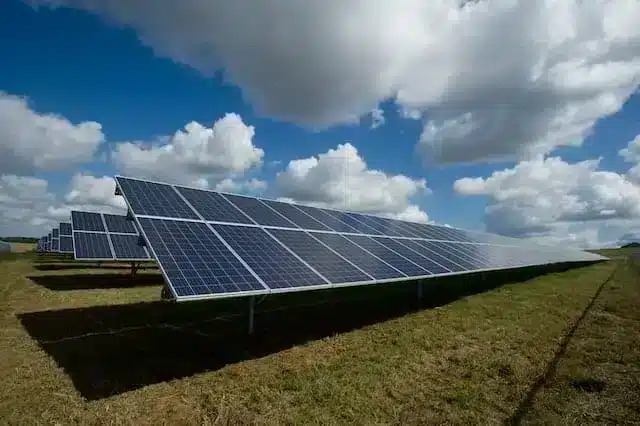
Today, most people will tell you that they have some sort of understanding of how solar panels work. After all, the concept is pretty simple, right? Panels installed on a roof absorb the sun’s energy and use it to power a person’s home or business.
The thing is, how does this happen? How can we get power from sunlight, and not only that but how does that power get converted into something that works with the electrical systems and appliances in our homes? Most solar professionals will tell you that while homeowners understand the general concept of solar PV, they are often less likely to understand the specifics.
Today, we will explain the exact process by which a solar photovoltaic (PV) system produces electricity, take a closer look at the components of a solar PV system, and explain what happens to any of the surplus energy generated by a solar system.
What is a Solar Photovoltaic System?
A solar photovoltaic system, commonly referred to as a solar PV system, combines everything necessary for sunlight to be gathered and converted into usable power. This includes the solar panels themselves, the materials used to anchor the panels to the roof, and the inverter used to convert your electricity, amongst other things.
Just buying and installing PV panels won’t be enough to convert sunlight into electrical power. More components are at play when generating free, renewable energy for a home. Before we get to how solar photovoltaic systems produce electricity, it’s essential to understand what role each component of a PV system plays in generating power.
Solar PV System Components
- Solar Cells: Typically made of silicon, solar cells are the main component of a solar panel. These are what produce energy through what’s called the photovoltaic effect. The most common varieties of solar cells are monocrystalline (one single wafer of silicon) and polycrystalline (combined shards/pieces of silicon).
- Solar Panels/Solar Modules: Solar panels house a group of solar photovoltaic cells and can be installed on a roof or the ground in a grouping called a solar array.
- Inverters: A solar inverter is the component of a PV system that converts the DC electricity generated by the solar cells into the AC electricity accepted by a home. Without an inverter, a PV array will not be able to power anything.
- Wiring: Wiring encompasses every cable necessary to connect each solar system component. Wires are used to connect PV cells into arrays, the array to the inverter and the disconnects, and the system to the grid and home.
- Racking: Racks are used to fix solar panels on roofs or the ground.
- AC/DC Disconnects: Required by most building codes, AC and DC disconnects are switches that can quickly stop the flow of electricity from solar arrays to both the home and the grid in the event of a fire or other emergencies, as well as for maintenance. You can think of solar disconnects as a kill switch for your solar system.
- Solar Trackers (optional): Solar trackers can be installed as a component of a ground-mounted system to enable the panels to “follow” the sun, allowing them to always tilt at the optimal angle to generate the most solar power possible.
How does Sunlight Become Usable Energy?
Unlike electricity generated from other sources like natural gas, coal, or nuclear energy, solar cells don’t rely on chemical reactions to produce power. Instead, they take advantage of the photovoltaic effect in which light (photons) hits certain crystals, such as the silicon you’ll see in solar panels, and agitates electrons, knocking them into an aluminum layer so that they can flow in the form of an electric current.
Solar panels have two layers of silicon, one that is positively charged, called the p-type, and one that is negatively charged, the n-type. The n-type semiconductor easily gives away electrons, while the p-type semiconductor is capable of receiving extra ones and letting the power flow freely.
From the panel, the electric current will flow through the system’s wiring to the solar inverter, which will convert the power from direct current (DC) to alternating current (AC). Solar inverters can be installed on each string of solar panels as a singular central inverter or come in the form of microinverters attached to each PV module itself.
Once the power hits the inverter, the electricity is ready to feed into the home and power anything from a toaster to an HVAC system.
What Happens When PV Panels Generate More or Less Solar Energy than Needed?
Unlike other forms of power, the sun isn’t always available when you need it. Solar panels will still generate electricity when it’s cloudy or snowy out, but what happens when the sun sets every night? Here are some common solutions for when your solar photovoltaic system generates more or less electricity than you need.
Solar Storage/Battery Backups
Taking the solar industry by storm, solar batteries are capable of solving the two most common problems associated with solar PV systems:
- Storing energy for use after the sun sets every night.
- Enabling a home to stay powered when the grid fails.
Many people don’t realize that unless you purchase an off-grid system, every other solar system must still be connected to the power grid. When the grid goes down, your system will also prevent you from using your solar panels during a power outage.
Adding solar storage to your system will free you from the grid, almost entirely, as long as your battery is large enough to store enough power to back up your home or the select appliances you’d like to use if the grid fails.
Solar batteries will also store extra unused energy generated during the day for use at night. Grid-tied systems will often use their solar panels during the day and then switch to drawing power from the electrical utility at night when the sun is down. Without a battery, you’ll still have an electricity bill if you need more power than you can generate.
While still quite pricey, at an extra cost of around $10,000+ depending on the model, they will save you money over the long term and provide you with extra peace of mind knowing that you’ll still have electricity in case of an outage.
Net Metering
Net metering policies aim to compensate solar power customers for the extra electricity they generate by allowing them to send additional energy back to the grid for other people to use. People will usually get credits in exchange for the extra power that they can use to offset their electric bills when they need to draw from the grid.
Feed-In Tariffs
Feed-in-tariffs maximize the benefits of renewable energy by taking advantage of a long-term price set by the government for any additional power generated by solar customers. This price is usually above the market price, making selling extra power back to the grid an attractive choice for people with solar systems. Feed-in tariffs are used globally and tend to have long-term contracts.
In Closing
Benefitting from solar PV is more than buying a few panels, throwing them on a roof, and enjoying unlimited solar power. In reality, there is a lot of interesting science, tools, and programs at play to help homeowners get the most out of their systems both through the energy they produce and through financial incentives to get them in the first place.
Looking to scope, sell and complete more solar projects than ever? Solargraf is the most user-friendly, robust, and fully integrated solution on the market. Book your free demo today to learn more about growing your business with Solargraf.
Ready to streamline your solar business? Discover solar software pricing now!


 United States
United States Germany/Austria
Germany/Austria Brazil
Brazil Netherlands
Netherlands